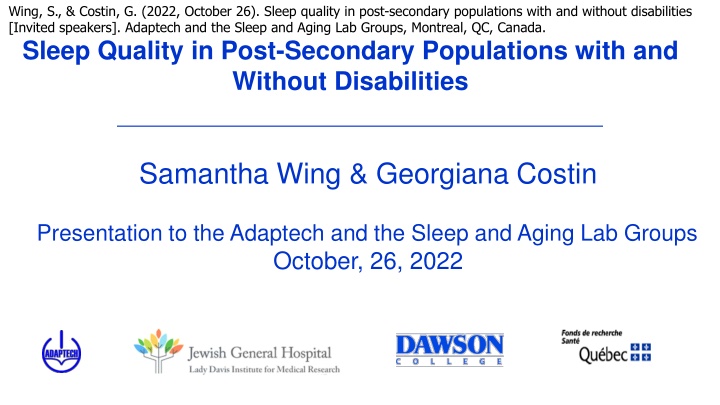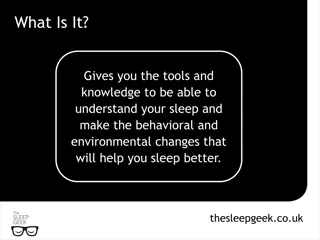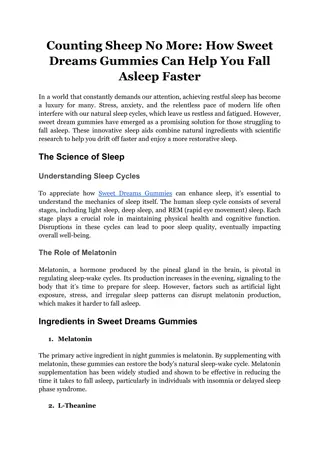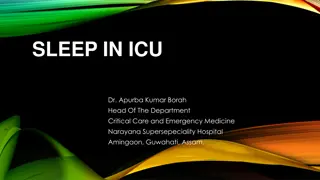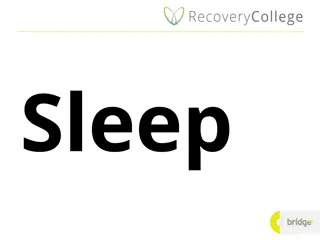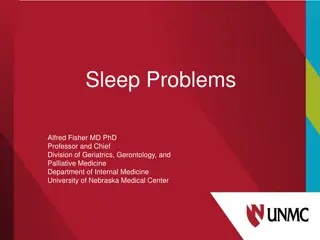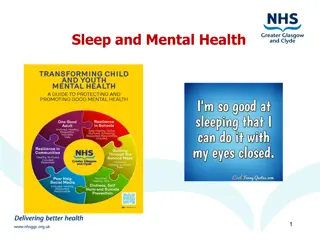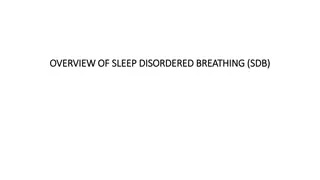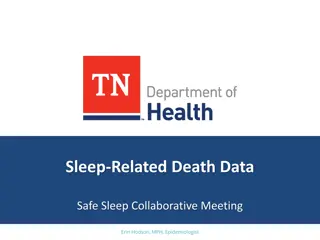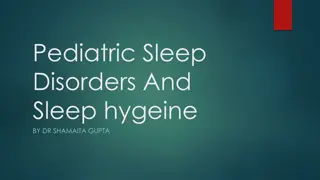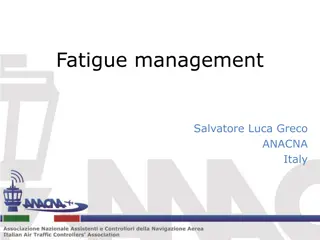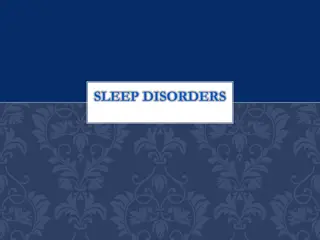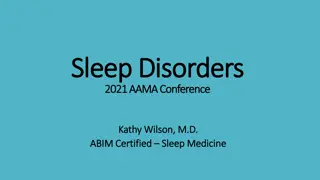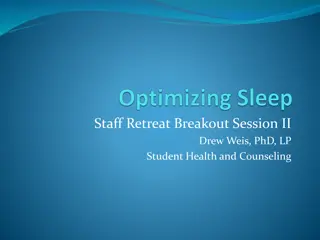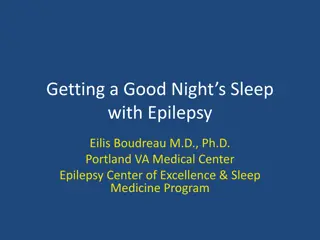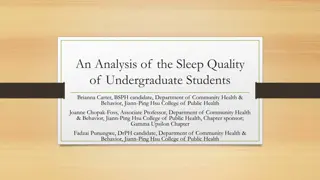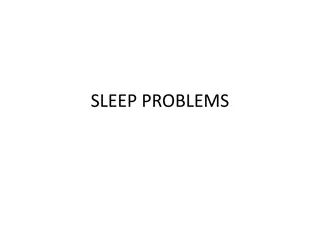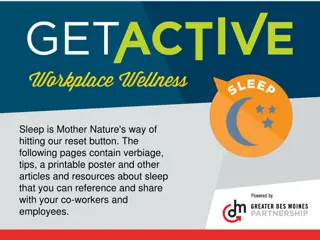Sleep Quality in Post-Secondary Populations: Impact of Covid-19 and Transition to Face-to-Face Learning
Explore the impact of Covid-19 on sleep experiences in post-secondary populations and the transition back to face-to-face learning, focusing on positive/negative outcomes and risk factors. The study aims to identify profiles at risk for negative sleep/well-being, factors enhancing resilience, and develop recommendations.
Download Presentation

Please find below an Image/Link to download the presentation.
The content on the website is provided AS IS for your information and personal use only. It may not be sold, licensed, or shared on other websites without obtaining consent from the author.If you encounter any issues during the download, it is possible that the publisher has removed the file from their server.
You are allowed to download the files provided on this website for personal or commercial use, subject to the condition that they are used lawfully. All files are the property of their respective owners.
The content on the website is provided AS IS for your information and personal use only. It may not be sold, licensed, or shared on other websites without obtaining consent from the author.
E N D
Presentation Transcript
Wing, S., & Costin, G. (2022, October 26). Sleep quality in post-secondary populations with and without disabilities [Invited speakers]. Adaptech and the Sleep and Aging Lab Groups, Montreal, QC, Canada. Sleep Quality in Post-Secondary Populations with and Without Disabilities Samantha Wing & Georgiana Costin Presentation to the Adaptech and the Sleep and Aging Lab Groups October, 26, 2022
Research Team Fichten, Catherine Asuncion, Jennison Bailes, Sally Costin, Georgiana Creti, Laura De Saedeleer, Sylvie Havel, Alice Jorgensen, Mary Libman, Eva Paul, Louise Rizzo, Dorrie Wileman, Susie Wing, Sam
Presentation Objectives Questions to address Goals Methods Qualitative study Phase 1 Phase 2 Hypotheses Quantitative study 3
Questions to Address What has been the impact of Covid-19 sleep related experiences On "back to face-to-face teaching, learning and working" What are the positive and negative outcomes For whom (gender, age, disability, group) Student, faculty, other staff Given "back to face-to-face" how can Positive outcomes be maximized Negative outcomes be mitigated 4
Goals Examine The "past" (remote learning) The "present" (face-to-face) Identify Profiles of those at risk for negative sleep and well-being Factors Associated with increased risk That are protective and/or enhance resilience Develop recommendations 5
Methods: Qualitative Study Three phases Individuals who were present During both remote and face-to-face learning Phase 0: email study of focus group participants Phase 1: consist of focus groups Phase 2: LimeSurvey comprising validated questionnaires We will study the following post-secondary groups Students: (1) with (2) without disabilities Faculty: (1) with (2) without disabilities Non-teaching staff: (1) with (2) without disabilities 6
Phase 0: Email Study - 1 Before the Zoom focus group Participants will answer questions by email Quality of sleep during remote learning semester (10-point scale) Quality of sleep during in-person learning/working (10-point scale) 5 Morningness/Eveningness questions (Chelminski et al.,2000) 7
Phase 0: Email Study -2 Hypothesis Eveningness chronotypes will have significantly better sleep quality during the remote than the in-person semester Especially true of students and faculty Morningness chronotypes will have significantly better sleep quality during the in-person semester than eveningness chronotypes 8
Phase 1: Focus Groups Research Ethics Board Certificate obtained 6 Zoom sessions 60 minutes 6-10 individuals for each of the 3 groups Prior to the focus group meeting Participants will be given the questions and the consent form 9
Phase 1: Focus Groups (contd) Questions Positive & negative contributors to sleep & well-being During the Covid-19 era During the return to face-to-face teaching, learning and working, Impact of the remote learning period on face-to-face experiences Responses will be coded Used to formulate Phase 2 open-ended LimeSurvey questions 10
Phase 2: LimeSurvey Self-report: listing of participants' disabilities Questionnaires & questions that inquire about Present: trait measures Gender, disability, personality, anxiety, distance from school Past & present evaluations Sleep-related Well-being Chronobiology Computer-related comfort Open-ended questions Family, work circumstances, health, topics from phase 1 focus groups Banerjee, M., Lalor, A. R., Madaus, J. W., & Brinckerhoff, L. C. (2020). A survey of postsecondary disability service websites post ADA AA: Recommendations for practitioners. Journal of Postsecondary Education and Disability, 33(3), 301-310. 11
Quantitative Email Study: Goals Examine The "past" (remote learning/working) The "present" (in-person learning/working) Identify "Early birds" (Morningness) "Night owls" (Eveningness) Analyze how morningness/eveningness chronotypes impact individuals in different contexts 12
Qualitative Study: Hypotheses Research is primarily descriptive Phase 2: we predict that individuals with Those who score high on Neuroticism and Trait Anxiety More sleep & well-being problems both past & present Problem family situations (e.g., young children, elderly parents) Better sleep and well-being during the present than the past High Extraversion will have worse scores during the past than the present On sleep, depression, anxiety, quality of life 13
